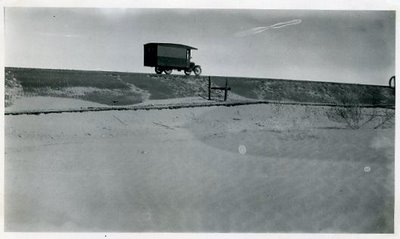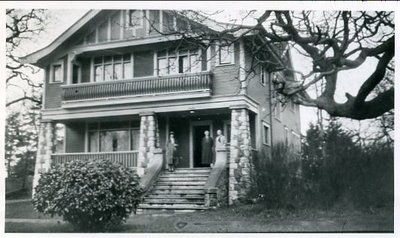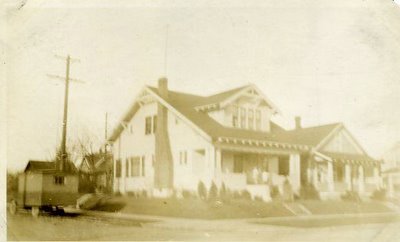From the Internet:
Crabgrass is a common weed that almost everyone knows. (The "great philosopher" Pogo said, "Work is the crabgrass in life."). {The Latin name, Digitaria, alludes to the finger-like spayed out ends.] Digitaria were introduced from Eurasia and are widespread throughout the United States. Crabgrass is found in turfgrasses (mostly smooth crabgrass) and in ornamental landscapes (primarily large crabgrass). Large crabgrass is also found in orchards, vineyards, and other agricultural areas. Crabgrass also has many other names including crowfoot grass and summer grass.
It was 1926 and the Sam Strachans had been married for twenty-five years. Sam built his own homemade version of an RV, a home on wheels they called “The Ranger,” and they set off to explore the Continent. Strachans never paid much attention to the 49th parallel, though it gave them trouble through tariffs at the border on their Kovar Kultivators. The tariffs would end the business but not yet. (If the tariffs hadn’t put Kovar out of business in Canada, the soon-to-come invention of herbicides would have anyway.)

After many adventures getting to Portland, that Christmas the couple lived in the Ranger on a parking lot across from the Congregational Church. Of course it rained the whole time, which Beulah, used to the high and dry prairie, thought was wonderful. She hung a bucket to the eaves and collected soft water for hand laundry. The two of them walked down to the waterfront where there were still sailing ships and they went to stage shows. In the daytime they separately patronized the YWCA and YMCA. Each of them kept journals which I’ve typed out and distributed around the family. It was quite like a second honeymoon, although they were so enmeshed and had been for so long, that there was no need for such an interval to restore their relationship. They just needed time away from the frontier prairie.

There were several stops to make through the Strachan diasphora. One was to Sam’s cousin, George Ramsey Jr., (the son of Sam’s mother’s sister Mary Welch who married George Ramsey Sr.), thriving in Victoria, B.C. (I have no b&d dates for these folks. The Welch girls were born and raised in Scotland in the last half of the 19th century.) Across the street from the very substantial Ramsey house was another, and looming over it was Craigdarroch Castle. Sam took a photo from the top floor of the Ramsey house. It didn’t look like the little pink Pickler mansion.

Cousin Will Harcus, son (or husband?) of Jean Ramsey daughter of Mary Welch Ramsey lived in Everett in a rather less palatial house.

A South Dakota neighbor, Will Jackman, also had a pleasant house nearby.

The Sam Strachan’s appear to have kept up their relationships with the homestead neighbors as much as they did with their genetic diasphora. Which are stronger: bonds of blood or bonds of shared experiences? Best is when the two are entwined. Which draws people closer together, hardship or good fortune? Hard to tell. Maybe hardship.
Having taken a good look at the Pacific Northwest, the travelers swung down to Purcell, Oklahoma, where Sam’s mother and her sisters and Sam’s sister Jeannie (1877-1957) -- a second wife to the widowed Harmon Archer (1869 - 1942) -- were living. Sam’s mother, Catherine Welsh Strachan (b.1852), was buried there in 1918 and Sam had taken his father Archibald’s body (b. 1850) to her side in 1926. Matt Robertson (1880 -1967), a cousin who is in this photo and who referred to Archibald as “Uncle Archie,” had a story about Uncle Archie’s small brother, whose leg had to be amputated for some reason. After a while, when the boy had recovered somewhat, he asked when his new leg would begin to grow back. An optimist, that boy! I have no idea what his first name was or what eventually happened to him.
Matt, who was a lawyer and probably could have been a writer, said that on the Welsh side the family was descended from John Knox, the great Scotch reformer, through his second wife. Matt said he was of the 11th generation but couldn’t prove it. Also, he claimed as ancestors King Robert the Bruce of Scotland and William Wallace, the Scots hero of the 12th Century. Jane Welsh, wife of Thomas Carlyle, and Jane Welsh, wife of Alexander Hamilton, were also claimed. There is a long story about John Brown Gillis and his children, which I won’t include here.
Harmon Archer’s house is also quite romantic, with gingerbread on the eaves, a square tower with a not-quite spire, and unique windows. The family often spoke of the “round window.” Note the amenity of the screen porch at the rear. The front porch, concrete, is rather Greek with its curves and columns. I believe Jeannie Archer lived here all her life after marrying in 1907, so that means she was in residence for fifty years. Her sister Jessie stayed in South Dakota -- quite a different life.

Beulah and Sam returned to the far north, encouraged by the success of others and with renewed confidence that there was still time to succeed themselves. They would make several other swings around the continent, to Ottawa, New England, and to Alberta. Even a visit back to South Dakota. They had escaped John Knox and his dour Scots devotion to duty.
1 comment:
Having lived in a home-made "RV", and having lived in Oklahoma, I can relate to some of the passages in this tale. I believe that the Greco-style round columns were commonly installed on porches built in the late 1890s/early 1900s. My great-grandparents's retirement home (in the "city"--about 10,000 people) sported them, too. Interesting tale that you've been stringing together and it's nice that you have the photos to go with it!
Cop Car
Post a Comment